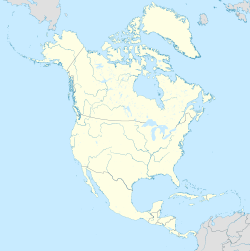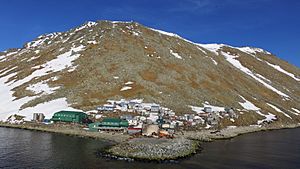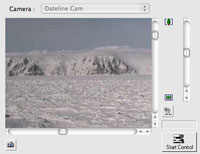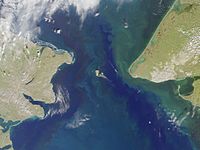Diomede, Alaska facts for kids
Quick facts for kids
City of Diomede
Iŋaliq (Inupiaq)
Диомид (Russian)
|
|
|---|---|

Aerial view of Diomede (2008)
|
|
| Country | United States |
| State | Alaska |
| Census Area | Nome |
| Incorporated | October 28, 1970 |
| Area | |
| • Total | 2.43 sq mi (6.30 km2) |
| • Land | 2.43 sq mi (6.30 km2) |
| • Water | 0.00 sq mi (0.00 km2) |
| Elevation | 1,621 ft (494 m) |
| Population
(2020)
|
|
| • Total | 83 |
| • Estimate
(2021)
|
82 |
| • Density | 33.72/sq mi (13.02/km2) |
| Time zone | UTC-9 (Alaska (AKST)) |
| • Summer (DST) | UTC-8 (AKDT) |
| ZIP code |
99762
|
| Area code | 907 |
| FIPS code | 02-19060 |
| GNIS ID | 1401213 |
Diomede (Inupiaq: Iŋaliq, Russian: Диомид, romanized: Diomid) is a small town located on Little Diomede Island in Alaska, USA. It is the only place where people live on this island. Little Diomede Island is in the Bering Strait, which is a narrow sea passage between the United States and Russia.
The town of Diomede is on the west side of Little Diomede Island. It is the smaller of the two Diomede Islands. The other island, Big Diomede, belongs to Russia. Diomede is home to about 82 people. Its native name, Iŋaliq, means "the other one" or "the one over there."
Contents
Exploring Diomede's Past
People have lived in the area where Diomede is now for at least 3,000 years. It was first a hunting camp in the spring. Early explorers found that the Iñupiat (Inuit) people of Diomede had a rich culture. This included special ceremonies for whale hunting. They also traded with people from both North America and Asia.
Early European Visits (1648–1867)
The first European to see the Diomede Islands was a Russian explorer named Semyon Dezhnev in 1648. Later, in 1728, another explorer named Vitus Bering found the islands again. He named them after St. Diomede, a saint honored in the Russian Orthodox Church on that day.
In 1867, the United States bought Alaska from Russia. This deal included Little Diomede Island. A new border was drawn, and Big Diomede Island became part of Russia.
Life in the Late 1800s and Early 1900s
In 1880, a count showed 40 people living on Little Diomede Island. A naturalist named John Muir visited in the 1880s. He noted that the native people were eager to trade their goods. The village was built on a steep, rocky slope that dropped sharply into the deep water. Most homes were made of stone with roofs of animal skin.
During the Nome gold rush around 1900, people from Diomede traveled to Nome. They used large skin boats called umiaks. They would stay in Nome for the summer to trade and gather supplies before returning to their isolated village.
Daily Life in the 1940s
In the 1940s, the Iñupiat people on Little Diomede lived by hunting and carving ivory. They would trade or sell their carvings. They caught fish like bullheads, tomcods, and blue cods. Whaling was still a very important activity.
In winter, they wore warm parkas and mukluks made from animal furs and skins. These clothes protected them from the cold and wind. For fun, they enjoyed skating, snowshoeing, handball, soccer, and Inuit dancing. In the evenings, they would tell jokes and stories.
In summer, they used skin boats with motors to travel to Siberia or Wales, Alaska. Winter travel was mostly limited to nearby Big Diomede Island because of the harsh weather. From July to October, about half the people went to Nome. There, they sold their carvings and skins and bought supplies.
Family Ties Across the Border
Even after the new border was drawn in 1867, families on Little Diomede had relatives on Big Diomede. The people on both islands were connected by family. Although it was officially forbidden, Inuit people from both islands sometimes visited each other. They would meet their relatives and exchange small gifts, sometimes hidden by fog.
Between January and July 1944, schoolteachers on Little Diomede counted 178 visitors from Big Diomede and mainland Siberia.
The Cold War's Impact
When the Cold War began in the late 1940s, Big Diomede became a USSR (Soviet Union) military base. All native people living there were moved to mainland Russia. If people from Little Diomede went too close to the Russian side, they were arrested. One survivor, Oscar Ahkinga, said that after 52 days of being held and questioned, the Iñupiat were sent away and told not to return.
School Life in the 1950s
In the 1953–1954 school year, the school on Little Diomede changed its schedule. Classes were held during holidays and some weekends. This helped students finish 180 days of schooling before the walrus migration in spring. The annual walrus hunt was vital for food and income, and everyone's help was needed.
The main language spoken was Inupiat, but students also learned English. The only way to talk to the outside world was through a "Bush Phone" in Nome. Basic health care also improved with seasonal teachers providing some medical knowledge.
Becoming a City (1970s)
During the 1970s, the village on Little Diomede became a permanent settlement. The entire island officially became the city of Diomede in 1970.
A Swim for Peace (1980s)
On August 7, 1987, American swimmer Lynne Cox swam between American Little Diomede Island and Soviet Big Diomede Island. She did this to promote peace and improve relations between the US and the Soviet Union during the end of the Cold War.
Later that year, Soviet leader Mikhail Gorbachev met with American President Reagan. Gorbachev toasted Lynne Cox, saying, "She proved by her courage how close to each other our peoples live."
Whaling and Family Reunions (1990s)
Even though Little Diomede was a whaling community, it was not first included in the Alaska Eskimo Whaling Commission. This meant its needs were not considered for bowhead whale hunting limits. In 1992, Little Diomede was officially recognized as a whaling community.
After the Cold War ended in 1991, people wanted to reunite with families across the Bering Strait. In 1994, the people of Little Diomede collected money and food. Local dancers practiced often. They prepared to host over a hundred friends and relatives from Siberia, showing great hospitality.
Diomede's Unique Location
Diomede is a small island, only about 2.43 square miles (6.3 km2) in total. It is located about 25 miles (40 km) west of the Alaskan mainland. It is very close to the International Date Line, which is only 0.6 miles (0.97 km) away. The Russian island of Big Diomede is just 2.4 miles (3.9 km) from Little Diomede.
Island Features
Little Diomede Island is made of granite. The town is built in the only area without steep cliffs leading to the water. Around the rest of the island, rocky slopes rise sharply. The island has very little plant life.
Weather and Climate
Diomede has a very cold climate, even though it's just south of the Arctic Circle. Winters are icy and colder than in Nome. This is because cold air from Siberia often reaches the island. Summers are very cool due to the nearby Bering Sea. This means most plants cannot grow well. The warmest summer ever recorded only reached 73 °F (22.8 °C).
| Climate data for Diomede, Alaska | |||||||||||||
|---|---|---|---|---|---|---|---|---|---|---|---|---|---|
| Month | Jan | Feb | Mar | Apr | May | Jun | Jul | Aug | Sep | Oct | Nov | Dec | Year |
| Record high °F (°C) | 53 (12) |
47 (8) |
42 (6) |
48 (9) |
56 (13) |
67 (19) |
72 (22) |
73 (23) |
65 (18) |
54 (12) |
45 (7) |
44 (7) |
73 (23) |
| Mean daily maximum °F (°C) | 7 (−14) |
4 (−16) |
5 (−15) |
16 (−9) |
32 (0) |
43 (6) |
52 (11) |
55 (13) |
44 (7) |
33 (1) |
22 (−6) |
10 (−12) |
27 (−3) |
| Mean daily minimum °F (°C) | −7 (−22) |
−9 (−23) |
−8 (−22) |
3 (−16) |
23 (−5) |
34 (1) |
43 (6) |
43 (6) |
37 (3) |
25 (−4) |
11 (−12) |
−2 (−19) |
16 (−9) |
| Record low °F (°C) | −44 (−42) |
−44 (−42) |
−42 (−41) |
−32 (−36) |
−11 (−24) |
20 (−7) |
24 (−4) |
30 (−1) |
23 (−5) |
−5 (−21) |
−28 (−33) |
−35 (−37) |
−44 (−42) |
| Average precipitation inches (mm) | 0.41 (10) |
0.45 (11) |
0.48 (12) |
0.27 (6.9) |
0.54 (14) |
0.73 (19) |
1.47 (37) |
2.46 (62) |
1.99 (51) |
1.41 (36) |
0.68 (17) |
0.52 (13) |
11.41 (288.9) |
| Average snowfall inches (cm) | 4.3 (11) |
4.1 (10) |
6 (15) |
3 (7.6) |
2.8 (7.1) |
0.2 (0.51) |
0.3 (0.76) |
0 (0) |
1.2 (3.0) |
6.3 (16) |
8 (20) |
5.3 (13) |
41.5 (103.97) |
Diomede's Population
| Historical population | |||
|---|---|---|---|
| Census | Pop. | %± | |
| 1880 | 40 | — | |
| 1890 | 85 | 112.5% | |
| 1910 | 90 | — | |
| 1920 | 101 | 12.2% | |
| 1930 | 139 | 37.6% | |
| 1940 | 129 | −7.2% | |
| 1950 | 103 | −20.2% | |
| 1960 | 89 | −13.6% | |
| 1970 | 84 | −5.6% | |
| 1980 | 139 | 65.5% | |
| 1990 | 178 | 28.1% | |
| 2000 | 146 | −18.0% | |
| 2010 | 115 | −21.2% | |
| 2020 | 83 | −27.8% | |
| U.S. Decennial Census | |||
Diomede first appeared in the US Census in 1880. It was listed as the Inuit village of Inalit. Over the years, its name changed in the census records. In 1970, it officially became an incorporated city.
In 2000, there were 146 people living in Diomede. Most residents were Native American. About 43.8% of the population was under 18 years old. The average household had 3.40 people.
Life in the Community
The area where Diomede is located has been used for at least 3,000 years. In the late 1800s, visitors saw people living in huts made of rocks with skin roofs.
The first square building on the island was a small Catholic church. It was built between 1936 and 1947 using wood donated from Nome. The next square building was a one-room schoolhouse. A new, larger church was finished in 1979.
Today, there are about 30 buildings on the island. Most homes were built in the 1970s and 1980s. There's a laundromat with washers, dryers, and showers. A clinic for basic health care is on the top floor of the same building. The island also has a school, a library, a heliport, and a satellite dish for TV, phone, fax, and internet.
There are no banks or restaurants. The main store has limited supplies like food, drinks, clothes, firearms, ammunition, and fuel. People often order other items like snacks and diapers from stores in Anchorage by mail. Like many other Alaska Native villages, selling alcohol is not allowed.
Power and Water
An electric system was built in the 1970s. Diomede Joint Utilities provides electricity using diesel generators. Large tanks store diesel fuel far from homes. The school and village store also have their own fuel tanks. Gasoline and propane are also used for power.
Water for winter comes from a mountain spring. It is treated and stored in large tanks. Because the ground is always frozen (called permafrost), pipes cannot be buried. Residents must carry water from the tank by hand. The water supply often runs out by March. When this happens, the laundromat closes, and people must melt snow and ice for drinking water.
There have been requests to improve the water system. This includes adding a separate tank for the school. Funds have also been asked for better trash collection and an incinerator. This is because the ground makes it hard to dispose of waste. People use honeybuckets and outdoor toilets, except in the laundromat, clinic, and school, which have a modern septic system.
Education on the Island
The Diomede School is probably the most isolated school in the United States. It has about 20 students from pre-kindergarten to 12th grade. There are usually three teachers. The school is part of the Bering Strait School District.
How Diomede Makes a Living
Jobs and Income
Most jobs on the island are with the city, the post office, and the school. There used to be some seasonal jobs in mining and construction, but these have decreased. The people of Diomede are skilled ivory carvers. The city helps sell their ivory carvings, mostly in Fairbanks and Anchorage, Alaska. Sometimes, carvings can be bought online.
The people also hunt whales in spring when there are openings in the sea ice. Whaling stopped for a while in the mid-to-late 1900s but started again in 1999.
Taxes
The city has a 3% sales tax. However, there are no property taxes on the island.
Getting Around Diomede
Travel in the Past
Over 10,000 years ago, Alaska was connected to Siberia by the Bering Land Bridge. Little Diomede was not an island then. It was part of Beringia and could be reached by walking. It's not known if humans visited the area at that time. Later, people likely walked across the sea ice to reach the island.
People used Umiaks (boats made of driftwood and whale skin) to visit Big Diomede for whale hunting and fishing. They also used them to reach mainland Alaska and Siberia. These traditional boats are still used today.
In the early 1940s, a resident wrote that airplanes rarely came to Diomede in winter. A ship called the MS North Star brought groceries from Nome. The Coast Guard cutter Northland visited twice a summer to check on the native people.
Travel on the Island
There are no roads, highways, or railroads on Little Diomede Island. The only ways to get around are by foot, ski, or snowmobile. There are old, faint rocky trails leading north and south from the city. Paths also connect buildings. In 2008, many footpaths in the city were replaced with wooden boardwalks and stairs.
Getting to and From Diomede
It is very hard and risky to travel to Little Diomede Island from the outside world. This is because it is so far away and the weather is severe. Strong winds, fog, and cloudy skies make transportation difficult. Even medical evacuations are challenging.
Mail has been delivered by helicopter since 1982. It now arrives weekly. This mail contract is one of the oldest and most expensive in Alaska.
A barge delivers goods and supplies once a year in the summer. This is usually the only large cargo delivery. When it arrives, all the men help unload and carry the supplies up. Other visitors include research teams, rare extreme tourists, and other Alaska Natives from the mainland.
Because of its location and weather, transportation to the island is very expensive. The city charges non-business visitors arriving by plane or boat a $50 fee.
When U.S. Senator Ted Stevens visited in 2002, he arrived by a National Guard helicopter. He said, "I did not realize you were this remote." It was the first time a statewide elected official had visited the island.
Helicopters
The main way to reach the island is by helicopter. Until the late 1990s, an old shipwrecked barge was used as a temporary landing spot. Today, the village has the Diomede Heliport. The U.S. Marine Corps built it in 2000. It is a concrete landing pad, 64 feet (20 m) by 64 feet (20 m). It is open to the public and has no control tower. It is the closest US heliport to Russia.
Since 2012, the United States Department of Transportation has helped pay for weekly helicopter flights between Diomede Heliport and Nome Airport.
| Airlines | Destinations |
|---|---|
| Pathfinder Aviation | Nome |
Airplanes
There are no permanent airports on Little Diomede Island. This is because of the island's rocky, steep slopes. In most winters, a temporary runway is cleared on the sea ice near the village. However, sometimes ice conditions prevent this. Some bush pilots have landed on the somewhat flat, rocky top of the island during snowy winters.
The only way to land an airplane during the few summer months is on water with a float plane. Any airplane landing on the island is very rare due to the high risk and severe weather. Studies have looked into building a permanent runway.
| Airlines | Destinations |
|---|---|
| Bering Air | Seasonal: Nome |
Boats
There is no port on Little Diomede Island. Thick Arctic sea ice means boats can only reach the island for a few months in summer. High waves and huge ice blocks make sailing very risky. Landing by boat is also hard and dangerous because of the island's rocky shore. The yearly supply barge and other boats usually stay offshore due to these conditions.
Future Transportation Ideas
There have been studies about improving transportation to and from the island. Ideas include building a port or a runway. There have also been proposals for an intercontinental tunnel or bridge between Alaska and Siberia. Some ideas suggest connecting the Diomede Islands to such a bridge or tunnel. This would make travel to Little Diomede much easier and safer.
These ideas for a bridge or tunnel have been around since the early 1900s. However, most have been just visions and have not led to official government studies by the US or Russia.
See also
 In Spanish: Diomede (Alaska) para niños
In Spanish: Diomede (Alaska) para niños







